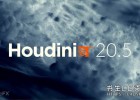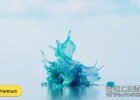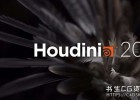CGWorkshops出品Houdini特效系列教程CGWorkshops - Introduction to FX using Houdini

CGWorkshops - Introduction to FX using Houdini
English | AVC 1280x720 15 fps | MP3 96 Kbps 22.05 KHz | 7.05 GB
Genre: eLearning | Level: Beginner
Spencer will cover a variety of material and get into many technical low level concepts, such as the maths, geometry, and trigonometry, etc involved in gaining complete control over an effect. When it comes to making great FX, there aren't any push-button solutions. This course helps to lay that groundwork to understand what is going on under the 'hood'.
Spencer will take you step-by-step through the construction of a production ready scene in Houdini - right from looking at the UI and procedural modeling in Week 1, and eventually on to particles and fluids. You will cover techniques that give complete control when you're creating cracks, wind effects, dissolving effects, as well as procedural modeling, to name a few..
Finally, you'll bring in the various elements you have created together in one final scene.
Week 1: The Always Exciting Part - Learning the UI and Constructing a Model
1. Proceduralism
2. User Interfaces
3. Creating Networks
Welcome To Week 1. This week we will be covering Houdini’s Procedural workflow, the User Interface, and explore a few of Houdini’s modeling tools. The goal by the end of the first week is to have a comfort level with Houdini’s interface as we will go straight into more complicated workflows and concepts throughout the following weeks.
Week 2: Copies are Cool, Copies are Cool, Copies are Cool - The Copy Operator and Noise
1. Copy Surface Operator
2. Stamping to Create Copy Variations
3. Noise
Can you feel the magic yet? For this week, we will cover the amazingness of the Copy Surface Operator (SOP) and its vast capabilities to create complex models, procedural animation and effects. We will also begin to cover the power of Noise and random values to give our geometry more organic behavior.
Week 3: POPs is the Magic Word - Introduction to Particles
1. Particle fundamentals
2. Controlling simulations
3. Writing Simulations to Disk
4. Apply Geometry to Particles
Particles. The bread and butter of Houdini. We will get into what a particle is, how we can control it using dynamic grouping, collisions and splitting. We cover how to surface and apply geometry to our particles.
Week 4: Is it me Or Are Particles Lazy? - Building Particle Emitters
1. Controlling Initial Velocity
2. Vectors - Length, Direction and Rotation
3. Dynamic Emitters
For this class, we will define where particles emit, set their initial velocity to direct our effect. We will learn how to set a vectors length, direction and rotation in order to maximize the amount of control we have.
Week 5: Other Fun Particle Tricks To Show Your Friends - Dissolving Geometry
1. Particle Attributes
2. Integrating particles with geometry
3. Advection using Voxel Fields
Dissolving geometry is always a good trick to own. We will look at a method of creating a dissolving effect that will eat away our model. We will explore the use of volume fluids to advect our particles to create natural, fluid motion.
Week 6: Sims are for Sucka’s! - Procedural Methods to create FX without simulation
1. Discuss goals when creating an effect
2. Geometry Attribute Types
3. Cover Math/Trigonometry topics to build robust effect
This week we will explore alternative methods for developing an effect without the use of simulations which can often allow for more flexibility, control, and increased efficiencies. We will get into using various attribute types as well a few trigonomic functions to produce a production level effect.
Week 7: Let’s Flip for FLIP fluids - Introduction to FLIP fluids
1. Particle Fluid fundamentals
2. Controlling Fluids with custom forces
We will take a look at Houdini’s FLIP particle fluid solver which is useful for creating...FLUIDS! Particle Fluids are used to generate splashes, sand, and oil to name a few. Key areas we will explore are the fundamentals of FLIP, various ways to control the properties, emission, and build custom forces to get the most out of our simulation.
Week 8: I Want To Be a Houdini When I Grow Up - Bringing It All Together
1. Bring Elements Learned Over Course Together
2. Render using Mantra.
The final week we will bring the various elements we have created together over the previous weeks. We will also explore some of the methods for rendering in Houdini.
官网:http://workshops.cgsociety.org/courseinfo.php?id=393
____________________________________________________________________
如需转载请注明:转载C4DSKY.COM
您的支持是我继续分享的动力,请支持原创文章
更多资源分享,请关注
书生新浪博客:http://blog.sina.com.cn/shushengstudio
书生新浪围脖:http://weibo.com/u/1895966073
书生淘宝店:http://shushengcg.taobao.com/
_____________________________________________________________________
如果网站为您提供了方便或者帮助到您,您也可以自愿赞助书生
赞助链接:https://me.alipay.com/shushengstudio
书生博客交流群:263413188
加群请注明:C4DSKY.COM
本站仅作为资源信息收集站点,无法保证资源的可用及完整性,不提供任何资源安装使用及技术服务。
如果文章内容介绍中无特别注明,本网站压缩包解压需要密码统一是:c4dsky.com
书生原创文章,版权所有,转载请注明,转载自书生CG资源网 » https://c4dsky.com/3033.html
版权声明:本站所有内容资源均来源于网络,仅供用户交流学习与研究使用,版权归属原版权方所有,版权争议与本站无关,用户本人下载后不能用作商业或非法用途,需在24小时内从您的设备中彻底删除下载内容,否则一切后果请您自行承担,如果您喜欢该程序,请购买注册正版以得到更好的服务!“版权协议点此了解”





 微信扫一扫,打赏作者吧~
微信扫一扫,打赏作者吧~












网友评论1条